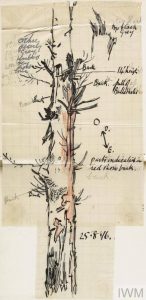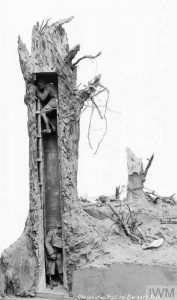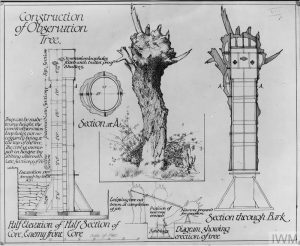Fake Tree Spy Posts in WWI
There’s a hidden history to fabricated trees that you might not be aware of: fake tree spy posts in WWI!
We often think of faux trees as strictly decorative, or for practical uses like concealing security cameras or support beams. In the days of World War I, however, fake trees had an even more important function. They were created and used as spy posts on both sides of the fight. The French came up with the original idea, and taught the British how to make them. Then the Germans caught on and used them to their own advantage. The countries that made up both the Allies and the Central Power used these tactics before the war’s end.
Today we call them fake trees, fabricated trees, artificial trees, etc. But in the early 20th century, they were referred to as “observation trees”. They share many similarities with the trees we create today, including the most important element: realism.
We pride ourselves on making impressively accurate, true to life fabricated trees that can blend in with natural landscaping. We also offer preserved trees, which look real because they are real! Sometimes our customers request something more artistic or interpretative, but the majority of our work is focused on precisely emulating real trees.
Realism is important in our work today, but it was a matter of life or death for soldiers in WWI. The fake trees they constructed didn’t just have to look like a real tree amidst others in a forest…they had to look exactly like a specific real tree that they had just removed.
If you were at war, and woke up one morning to see a brand new, fully grown tree near the front lines, you would be understandably suspicious. That’s why soldiers had a meticulous process for every stage of this endeavor. Some of the steps they took are very similar to what we still do today!
First, the soldiers would select the appropriate tree. It needed to be big enough to hide inside, and both tall and close enough to afford a good view of the enemy. They preferred trees that had already been bombed, because those were easier to remove and replicate.
Once a tree was chosen, it was carefully measured, sketched, and photographed. Bark samples were a crucial step taken to ensure a realistic tree. These were then paired with plasticine molds of trees that could be customized to become an exact match.
It’s very impressive that they were able to create realistic bark, because their materials were so limited. The trees began as 16 separate sections of hollow steel tubes. These were bolted together with painted, wrinkled iron layers that served as tree bark. Various rough materials like seashells were crushed and applied to replicate the look and feel of real bark.
The hollow steel trees didn’t have much inside, aside from small seats, viewing holes, and scaffolding used for stability. A rope ladder was generally secured near the top, allowing a soldier to climb up and monitor the surroundings. Telescopes and periscopes were used to give them a greater field of vision.
Before the trees could be utilized, though, they had to be installed. This had to happen at night, using the sounds of artillery to mask their work. The old tree had to be removed, and a hole would be dug in the place of the roots. The bottom of the new tree had a steel base that would be secured deep underground.
When morning came, the enemy wouldn’t see anything amiss – just the same dead trees that were there the evening before! Inside, though, were camoufleurs (Camouflage Officers) from the other side, observing and relaying their activities to superiors.
Soldiers used this advantage to learn the general tactics and weaponry employed by the enemy, as well as discovering future battlegrounds or surprise attack sites.
These decoy/camouflage trees no longer stand, but some can be found in various museums. The Australian War Memorial and the Imperial War Museum – London both house authentic observation trees used by the British and Germans.
We haven’t made this exact type of tree, but we have produced something similar. The image below shows an artificial cacti grouping that conceals hidden recording devices. It was designed to be positioned in front of a rock outcrop, which agents could hide behind. We have many options for wireless concealment and trees with embedded technology, so the only limit is your imagination. We can definitely make you a secret observation tree if you would like. It can be designed for adults to use in the real world, or on a smaller scale for a kid’s treehouse feature!
Learn More:
- The Journey of the Camouflage Tree
- Can’t See the Tree for the Wood
- Can’t see the tree for the wood… part II : The Baumbeobachter
- The Army’s special branch: How bizarre fake spy trees appeared in no-man’s land during WWI (and killed hundreds of soldiers)
Watch the video below to see how one of these camouflage trees was cleaned and preserved:

Image credits: First World War Galleries, Imperial War Museums – London 
Image credits: First World War Galleries, Imperial War Museums – London 
Image credits: First World War Galleries, Imperial War Museums – London 
Image credits: First World War Galleries, Imperial War Museums – London
